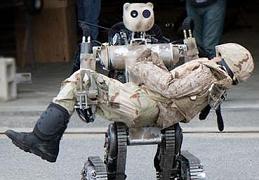Nov 29 2010
The U.S Army is testing the Battlefield Extraction-Assist Robot (BEAR) for deploying the robot in saving injured military personnel caught under fire.
The Army has reported that in the previous year the BEAR robot was analyzed by military troops at the U.S. Army Infantry Center Maneuver Battle La, Fort Benning. The humanoid robot can be remotely operated by means of a movement-capture glove or a specifically developed rifle grip.
 BEAR
BEAR
The BEAR Robot was developed by Vecna Technologies and this research was sponsored by the U.S. Army Medical Research and Materiel Command's Telemedicine and Advanced Technology Research Center (TATRC). The incorporation of M-4 rifle grip controller and AnthroTronix's iGlove into the Fort Benning facility was also funded by TATRC.
Gary Gilbert, who manages the medical robotics portfolio of TATRC, has stated that they are determined in offering the technology to the soldiers of the US Army, either by means of live or simulated exercises. The appropriate strategy, methods and techniques from the feedback of the soldiers will be ascertained, followed by deploying the updated technology. He added that the strategy, methods and techniques will act as basis for creating real-world operational requirements.
The US Army had stated that a simulated version of the BEAR was developed in 2009 to utilize it in the One Semi-Autonomous Forces combat operations simulator of the battle laboratory. A preliminary range of platoon-level attacks and rescue tasks in both urban and countryside terrain were performed in the simulator. It also included removal of casualties by using both traditional debris rescues as well as rescue operations with BEAR.
The incorporation of AnthroTronix remote control systems into the simulated version was made in December 2009 and the live depiction studies of AnthroTronix controllers and BEAR were performed in June 2010.
The multi-modal BEAR can transport up to a weight of 500 pounds. It features high-degree of freedom, cameras, sensors and a dual-track system for effective maneuvering. A human operator has to operate the robot during the initial phase of rescue tasks. However, research is still in progress for adding more intricate semi-automatic attributes which enables the humanoid to understand and perform advanced instructions.